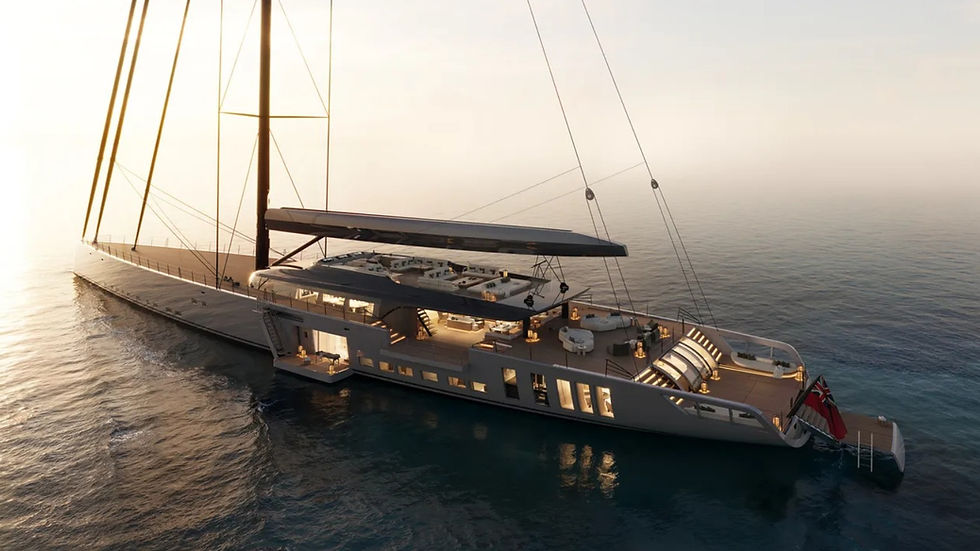Innovators in Boating - John L. Hacker & Hacker-Craft
- Richard Crowder

- Dec 12, 2023
- 6 min read

As a boaer, you have probably heard of Hacker-Craft and their superbly built classic wooden boats. But like me, before I researched their history in powerboating, you may be surprised at Hacker-Craft's influence in the development and innovation seen in pleasure boats today. For example, they are the oldest continuous manufacturer of wooden pleasure boats in the world.
Hacker-Craft takes us back to the very beginning of powerboating. It was 1877 when John L. Hacker was born, and it was only nine years later in 1886 when Daimler and Maybach first installed an internal combustion engine (ICE) in a boat, thus starting the birth of motorboating. At age 14, Hacker built his first boat – a rowboat. Shortly thereafter, he became a bookkeeper in his father’s business. But his first love was boating.
After four years of night school and correspondence courses, at age 22 in 1899 'John L.', as he became known, graduated as a boat designer and naval architect. He focused his design efforts on making boats go faster. As he saw it, there were two basic problems that had to be solved. Most boats of the day were very narrow and double-enders in design, so when a heavy ICE was added toward the back, the stern would squat down and the bow would rise. This became even worse when the boat was underway.
The second problem was that boat bottoms in those days were rounded. That, coupled with the sinking stern, kept the boat in displacement mode. John L. recognized that the boat would have to rise up and “plane” on top of the water in order to become faster.
To solve these two issues, he designed a wider beam which carried further aft. He also added a flat transom to give more flotation to the stern. This was to get rid of the stern squat. He also redesigned the bottom of his boats to have a V-design with flatter sections – not as a deep-V – but nevertheless a moderate-V with harder chines that would aid in allowing the boat to get on plane.
In 1904, a short five years after he started, John L. designed and built his revolutionary Au Revoir with a shallow V-bottom design and promptly set the record as the world’s fastest boat. Then, in 1908, he became a full-time boat builder when he purchased the Detroit Launch and Power Company and changed its name to the Hacker Boat Company. This was at the same time that his friend Henry Ford drove his first-ever Model-T Ford off his assembly line in Detroit.
In addition to Henry Ford, John L. had also become friends with the famous Wright brothers of nearby Dayton, Ohio. In 1903, the brothers had made the world’s first powered flight in the Wright Flyer from Kitty Hawk, North Carolina. Later on, Hacker designed a set of pontoons for the Wright’s for their CH-Flyer biplane in 1911. This was claimed to be the world’s first application of two pontoons on a plane, a practice that soon became common.
Also in 1911 in deference to the Wright brothers, Hacker designed and built Kitty Hawk, the first stepped-hull hydroplane design which not only won the APBA Gold Cup that year but set an unthinkable world speed record of over 50 miles per hour. Equipped with a Sterling engine, it held the record as the world’s fastest boat from 1911 to 1915. Sterling engines powered many early Hacker-Craft boats and powered every Gold Cup winner from 1912 to 1917. John L. Hacker created more race-winning designs over his six decades than all other builders combined. Hacker-Craft “Sterling” models would later appear in their lineup.

In 1918, for better weight distribution, John L. moved the engine forward and closer to mid-ship in a 32-foot family boat and installed the cockpit and controls forward of the engine, thus creating the classic runabout layout that was subsequently followed by other builders. In the same year, he was credited with coining the term “runabout” to describe this style of boat. In 1921, he built six runabouts which became famous as the Belle Isle Bear Cats of Detroit, cementing his position as America’s most influential runabout designer and builder.
The publicity boosted sales of their family-style “runabouts,” as well their gentlemen racer and sportster models. In 1914, he moved his boat-building facility closer to downtown Detroit and added a second location in Mount Clemens, Michigan in 1921. In 1923, he moved his entire operation to the Mount Clemens facility on the Clinton River off Lake St. Clair, just north of Detroit. Hacker-Craft was building boats for the elites of the rapidly growing automobile industry centered in Detroit and nearby Grosse Point.
The depression of the 1930s was devastating to most boat companies, including Hacker-Craft, but it was a period during which John L. produced some of his most memorable designs. He designed and built the shingled bottom monohull El Lagarto, powered by a Packard engine, which won the Gold Cup for three consecutive years in 1933, ’34, and ’35.
Later in 1935, El Lagarto set a speed record of over 72-mph. The shingled bottom acted as tiny “steps” in the hull to disturb the surface tension drag of the water by breaking up the water and introducing air. It is said that Hacker-Craft set more than 20 speed records, built five different Gold Cup winning boats, and produced four President’s Race winning boats. Their technological prowess for race boats soon transferred to family pleasure boats.
The production of a 17-foot utility runabout in 1935 that retailed for less than $1000 helped Hacker-Craft survive the Depression. Then in 1939 came arguably John L’s most famous production when he was commissioned by real estate mogul George Whittell to design the 55-foot commuter boat Thunderbird which was later commemorated on a US postage stamp.
The boat is still in use over 80 years later at its original Thunderbird Lodge boathouse on Lake Tahoe. It has had regular maintenance and restoration, and its original twin V-12, 550 hp Kermath engines were replaced with twin Allison V-1710, V-12 water cooled WWII aircraft engines pushing to 2300 hp each. Thunderbird hosted 70 mph cocktail parties at various times for guests including headliners such as Tony Bennett, Frank Sinatra, Sammy Davis Jr, and Liza Minnelli.
The company survived the Great Depression and kept active during the 40s and 50s, including substantial US Government military contracts starting in 1952. Those new endeavors included a wide range of designs and builds including patrol boats, air-sea rescue boats, and over a hundred crash boats over 40-feet long.
John L. Hacker passed away in 1961 at age 84. However, just prior in 1959, William Morgan of Morgan Marine in Silver City, New York acquired the rights to Hacker-Craft. By using new technologies like epoxies and resins, Morgan set out to strengthen and modernize the construction of Hacker-Craft boats while still keeping their classic appearance. By switching to modern higher horsepower engines, speed and handling improved as Hacker-Craft entered a new era.
In 2004, then again in 2008, the company was sold and eventually moved to Ticonderoga, New York, still on Lake George. Hacker-Craft has concentrated in the time since to build mainly their classic boats that made their name synonymous with luxury. Their boats have been featured in advertising and promotions by companies like Neiman Marcus, Tommy Bahama, and Tommy Hilfiger. They even went as far as to develop a Neiman Marcus Edition model in 2011 and a Tommy Bahama Edition model in 2012.
The company moved its facilities once again in 2021 to Queensbury, New York, still on Lake George, but at the south end. Despite all the moves, the Hacker Boat Company can still claim to be “the world’s largest builder of classic mahogany motorboats.” Since 1929, every Hacker-Craft logo on every boat has been produced by hand using a gold gilding technique with ultra-thin 23 carat gold leaf sheets.
Today, the Hacker-Craft Legacy Collection series offers models in Sport, Sportabout, Runabout, Sterling, and Racer categories ranging from 22 to 35 feet. Its Aquavant Collection series offers fully customizable models in Commuter sedan layouts, Center/Side Consoles with inboard or outboard power, the modern Monaco cuddy cabin layout, and most recently, in partnership with Ingenity, the Electric series of battery-powered runabouts. In addition to new and used boat sales, the factory also spends a considerable portion of its time on restoration of various brands of wood boats.
Hacker-Craft boats were once named by Forbes Magazine as one of “America’s Top 50 Products” and it's easy to see why. John L. Hacker built a reputation as a designer and boat builder for quality, luxury, and performance and imparted those qualities along with innovations to his boats. These qualities live on in today’s Hacker-Craft boats.































Comments